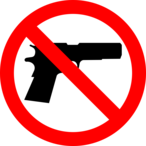
It Is ILLEGAL To Carry A Firearm In Any State Prohibited Area
Prohibited areas do not include businesses that post “No Weapon” signs
More Information About No Weapon Signs
- “Secure area” means an area created under this section into which certain individuals are restricted from transporting a firearm or other dangerous weapon, ammunition, or explosive.
- “Secure area” does not include any area normally accessible to the public.
An individual cannot carry in any secure area described in Section 76-8-311.1 and Section 53- 5a-S102.2 under Subsection (2)(a), (2)(b), (2)(c), and (2)(d), unless exempt under 53-5a-108.
- An individual openly carrying or concealing a firearm without a concealed firearm permit may not carry the firearm on or about the premises of a public or private elementary school or secondary school as described in Section 76-11-205, on or about the premises of an institution of higher education as described in Section 76-11-205.5, on or about the premises of a daycare as described in Section 76-11-206.
- An individual with a valid concealed firearm permit, a temporary concealed firearm permit, or a provisional concealed firearm permit may not carry the firearm in the following locations.
- State Tax Commission. (prohibited in secure areas only)
- Correctional facility as defined in 76-8-311.3.
- Law enforcement facility as used in 76-8-311.1. (1)(a)(v).
- Courthouse or Courtroom per 78A-2-203.
- Mental health facility as defined in Section 26B-5-301.
- Higher education secure area hearing room as described in 53b-3-103.
- An airport secure area as described in Section 76-11-218.
- A house of worship or private residence where dangerous weapons are prohibited, as described in Section 76-11-219.
- Any other place prohibited by, or pursuant to, another state statute or federal law.
Laws
- 53-5a-107. Compliance with firearms prohibitions in secure facilities.
- 53B-2-101. Institutions of higher education — Corporate bodies — Powers.
- 53B-3-102. State institution of higher education defined.
- 53B-3-103. Power of board and institutions to adopt rules and enact regulations.
- 76-8-311.1 Establishment of secure areas — Items prohibited — References to penalty provisions.
- 76-8-311.2 Prohibited dangerous weapon or ammunition in a secure area.
- 76-8-311.3 Establishment of prohibited item policy in a correctional or mental health facility — Reference to penalty provisions — Exceptions — Rulemaking.
- 76-8-311.4 Prohibited item in correctional or mental health facility for use by offender or detainee.
- 76-8-311.6 Possession of prohibited item by offender or detainee in correctional or mental health facility.
- 76-8-311.7 Possession of prohibited item in correctional facility or secure area of mental health facility.
- 76-11-218. Possession of a dangerous weapon in an airport secure area — Reporting requirements.
- 76-11-219. Trespass with a firearm in a house of worship or a private residence.
- 78A-2-103. Definitions. (Courts)
- 78A-2-203. Rules — Right to make — Limitation — Security.
